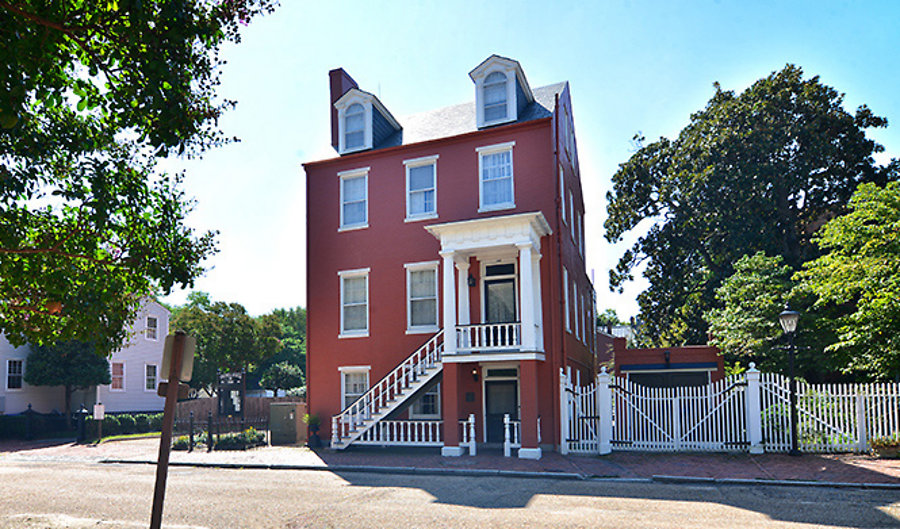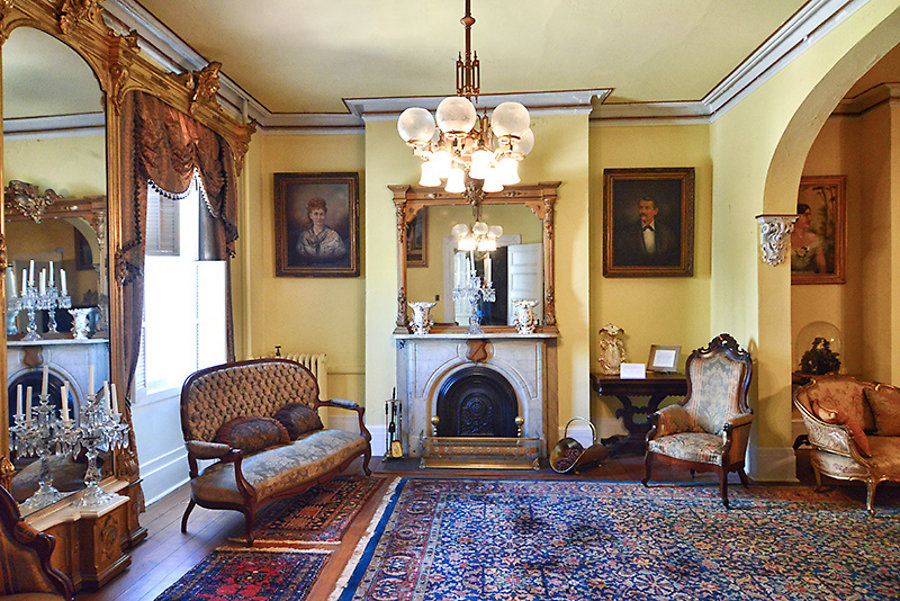 THE HILL HOUSE MUSEUM Imagine a family went for a stroll and never returned home by Rob Lauer To stroll the brick sidewalks of historic Olde Towne Portsmouth is to feel as if one has walked back in time. Stately Federal and Greek Revival townhouses line one street. Antebellum and Victorian homes adorn another. Olde Towne Portsmouth boasts the largest collection of historic homes north of Charleston and south of Alexandria- all due to a fluke of history. During the American Revolution, the majority of Portsmouth citizens were loyal to the King. When the British bombed and burned neighboring Norfolk, they left Portsmouth untouched. Because the Federal Shipyard was located in Portsmouth, the city came under Union control early in the Civil War, thus saving it from the destruction that fell upon many Southern towns. Despite the variety of beautiful historical homes in Olde Towne, one on North Street particularly grabs the attention of passers-by. A tall, sturdy Federal-style brick home with four floors, its trim and the picketed gateway to its side are painted a creamy white. A graceful front staircase leads up to the porch and formal front door on the home's second story. This impressive edifice is the Hill House. Built around 1825 by John Thompson, a Portsmouth entrepreneur and brick-making business proprietor, the home was passed down to his descendants until the late 1950s. It was then that the three surviving Hill sisters- Elizabeth, Evelyn, and Frances- decided to make a gift of their ancestral home and its contents to the Portsmouth Historical Association. Their bestowal included every piece of furniture, china, crystal, pottery, carpet, and every item that had been collected for 190 years by their extended family. Now known as the Hill House Museum, the house is open for tours twice a week, each May through December. Whereas many historic homes feel like museums, the
feeling upon entering the Hill House is surprisingly different. Though
the furnishings and fixtures are antiques, one initially feels as if
this is a private home in which a family still lives. One might be
tempted to pause and listen for family conversation drifting down the
hall from somewhere in the back of the house. According
to David Reitz of the Portsmouth Historical Association, who leads
tours of the home, everything in the Hill House was left as it was when
the last of the Hill sisters left there in 1963. "When
you walk into this house, it's like the family went out on a Sunday
stroll, but never returned," he notes with a smile. "It's very unique.
You don't have many historic homes in the United States where everything
in them, down to the clothes hanging in the armoires, are original to
the owners of the house."  The Hill House Museum in Olde Towne Portsmouth Another unique feature of the Hill House is that its ground floor is an English basement. "The less formal guests would have been greeted downstairs in the English basement part of the house," David explains. Continuing down the impressively decorated hall, he enters a large ground floor parlor at the front of the house. "When you walk in, you enter this first room- which we call the flop room," he says. "Nowadays, we walk into our living rooms and flop down on our sofas. That's basically what they would do here. This is the less formal part of the house." Glancing around the so-called flop room, one realizes that concepts of informality have certainly changed over the past 195 years. Heavy velvet curtains of deep red hang on all of the windows. Persian carpets adorn the hardwood floors. Given the beautiful Victorian furniture, it is doubtful that the initial impulse of most moderns would be to "flop" down in it. A gorgeous fireplace topped with a gilded mirror dominates the room. The dining room, which would have been used daily by the family, is also on the ground floor. With the gorgeous velvet curtains and beautiful wood furniture, it looks no less formal to modern eyes than the "flop room." At the back of the house on the ground floor is the home's large kitchen. Originally the kitchen was detached from the house- as was customary in the early 1800s. Later in the 19th century, it was connected to the house by a hall. "You don't have many historic homes in the United States where everything in them, down to the clothes hanging in the armoires, are original to the owners of the house." - David Reitz "The evolution of the house is most evident in the kitchen," David points out. The evolution of the American kitchen from the early 1800s through the 1950s is also on display there. A large fireplace is at the back of the kitchen. In it, meals were once prepared by the family's cooks. During the last half of the nineteenth century, a large cast-iron stove was installed in front of the fireplace, and the technology of meal preparation in the Hill House advanced. The innovations didn't end there. "To the right of the cast-iron stove is a 1950s electric stove along with a GE electric refrigerator," David continues, pointing at kitchen appliances Baby Boomers would remember from childhood. It is on the second floor that the home's opulence is most on display. Formal guests would have ascended the outside front staircase and been received here. Two large adjoining parlors dominate the second floor, bedecked with marble fireplaces, thickly gilded mirrors and windows, chandeliers, exquisite Persian carpets and heavy velvet curtains. "The Hills had four U.S. Presidents visit this home," David continues. "The first president was Polk, then Buchanan, Fillmore and Tyler. This is the parlor where they would have been greeted. They probably would have had some tea, socialized with the men, and just relaxed and visited." The bedrooms on the Hill House's third and fourth floors have been preserved with the same attention to detail, leaving visitors with the feeling that someone slept in them just last night. The feeling of having traversed time and experienced life centuries ago makes a visit to the Hill House a unique experience. "If anyone wants to be a part of this history," David says with a smile, "we invite them to come and check us out."  The second floor parlors of the Hill House where four US Presidents were received as guests Hill House Museum 221 North Street Portsmouth, VA 23704 757-393-0241 www.thehillhousemuseum.org |